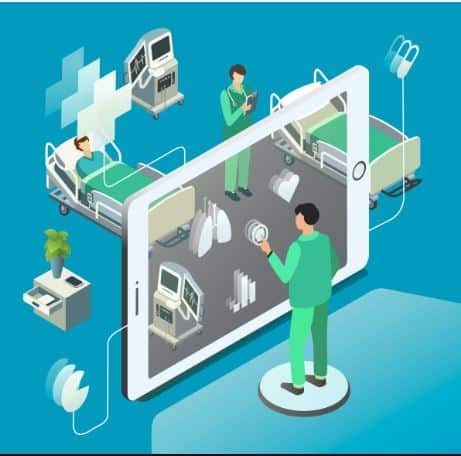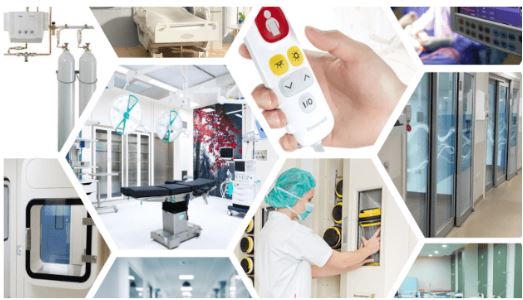Smart Hospitals: Modular, AI-Driven Healthcare Infrastructure
introduction
Modern healthcare solutions are transforming hospitals into “smart” centers of care. Faced with growing patient demand and staff shortages, hospital leaders are investing in digital infrastructure that automates workflows, enhances connectivity, and integrates medical devices. According to an article published on Philips website, by 2025, over 90% of healthcare executives view automation as critical to relieving clinical staff from routine tasks. Innovations like generative AI assistants can summarize clinical notes, interpret imaging data, and translate complex reports into plain language, giving care teams more time with patients. In this way, smart hospital systems—from hospital automation to AI-driven analytics—are delivering better care to more people with greater efficiency.
- For example, patient-monitoring systems now form open, interoperable networks. Connected monitors and medical devices feed into unified dashboards, so clinicians instantly see a patient’s vital signs, imaging, and lab results in one view. This vendor-neutral interoperability breaks down data silos, enabling advanced algorithms to predict risks (like sepsis or cardiac events) before they occur.
- Generative AI tools are emerging as virtual assistants for clinicians. Philips reports that 85% of healthcare leaders plan to invest in generative AI by 2027. AI can auto-generate discharge summaries or patient instructions, freeing nurses and doctors from administrative paperwork.
- Telehealth and remote monitoring have also matured. Advanced telemetry devices and home-based IoT sensors allow patients to be cared for “hospital-at-home,” easing capacity constraints. In fact, one survey found that 41% of healthcare leaders plan to deploy AI-driven remote monitoring in the next three years. These systems continuously track symptoms (heart rate, glucose, etc.) and alert clinicians to issues early, improving outcomes and reducing readmissions.

AI-Driven Healthcare System Solutions
Artificial intelligence is at the core of next-generation medical systems projects. Hospitals are shifting from pilot programs to enterprise deployments of AI tools that improve clinical and operational workflows. For example, ambient listening devices (AI microphones) automatically transcribe doctor-patient conversations, auto-populating electronic health records and coding charts. This reduces burnout and allows clinicians to focus on the patient. Other AI applications include:
- Diagnostics: Machine-learning models analyze medical images (CT, MRI, X-ray) and pathology slides to detect findings faster and more consistently than before. Already, AI aids in radiology and pathology, and Philips notes a “silent revolution” in image-guided care for interventions and surgery.
- Predictive Analytics: By combining a patient’s entire digital record with thousands of similar cases, AI algorithms can recommend personalized treatment plans and alert staff to impending crises. For instance, an ICU dashboard may use real-time data to forecast which patients are at risk of complications, enabling preemptive action.
- Operational AI: Beyond clinical uses, hospitals use AI to optimize staffing, supply chains, and equipment maintenance. “Smart rules” engines monitor device alerts and schedule preventative service, minimizing downtime of hospital equipments.
The result is a healthcare ecosystem that learns and adapts. As Philips reports, 92% of health leaders see automation as essential to address staff shortages. In 2025 and beyond, AI-driven tools will continue to streamline everything from documentation and diagnosis to patient engagement.
Modular ORs and Flexible Infrastructure
The second pillar of smart hospitals is modular infrastructure. Traditional hospital construction can take months and require shutting down ORs or wards for renovation. Today, hospitals are turning to prefabricated, modular solutions for operating rooms, ICUs, cleanrooms, and even entire wings. These hospital projects use custom-built wall and ceiling panels with built-in medical gas, electrical, and IT conduits. Key benefits include:
- Rapid Deployment: Prefabricated OR units can be manufactured offsite and installed in weeks rather than months. This minimizes disruption; renovations are completed faster because walls and ceilings are assembled like a kit.
- Integrated Services: In modular ORs, all plumbing, wiring and outlets are pre-installed in the panels. This “plug-and-play” design means new equipment (e.g. endoscopic towers, imaging devices) can be added with minimal downtime. Hospitals can reconfigure rooms or add technologies (like robotics or imaging) without extensive construction.
- Infection Control & Design: Modules come with antimicrobial finishes (e.g. stainless steel, glass) and seamless surfaces for easy cleaning. Designs are fully customizable in size, shape and color, letting each OR or ICU meet specific clinical needs.
These modular solutions are ideal for critical hospital areas. For example, Operamed’s modular wall and ceiling systems allow night-and-weekend upgrades of ORs. Technicians can swap out old panels or install new service lines in off-hours, so the room can “go live” again almost immediately. The result is continuous uptime in revenue-generating spaces while still adopting cutting-edge medical devices and systems.
Hospital projects from design through deployment now emphasize this flexibility. Many new ORs and ICUs are delivered as modular kits, often including high-tech features like integrated touchscreens and built-in diagnostic equipment. Ultravision’s modular OR offerings (with partners like ALVO) exemplify this trend, enabling quick build-outs of fully equipped surgical suites.
Hospital Automation and Medical Systems
Smart hospitals also automate internal logistics and communications. Hospital automation ranges from simpler upgrades (wireless nurse-call alerts) to fully automated transport systems. Key components include:
- Pneumatic Tube Systems (PTS): PTS networks swiftly move blood samples, lab specimens, medications and documents between floors and departments. Swisslog reports that in hospitals using PTS, carriers dispatch every 20 seconds on average. By automating delivery of urgent items, PTS dramatically reduce turnaround times. Clinicians rely on PTS for tasks like rushing blood units to the ER or sending biopsy samples to the lab, which speeds up diagnosis and treatment.
- Nurse Call & Communication Systems: Advanced nurse-call platforms (e.g. Honeywell systems) integrate bedside alerts with mobile apps and real-time location tracking. When a patient presses a call button, the nearest available nurse is alerted via tablet or smartphone. This closes response loops faster than old pagers or static call panels. Analysts predict the global nurse-call market will grow ~9.5% annually through 2030, reflecting this shift to smart communication.
- Robotic Assistance: Autonomous robots are entering hospitals to handle repetitive tasks. For instance, delivery robots transport meals or linens, disinfecting robots scrub rooms, and surgical robots perform precise minimally-invasive procedures. Philips notes that minimally invasive, image-guided interventions are “marching ahead” in 2025, and robotic surgery systems are integral to that trend.
- Integrated Transport & Materials Management: In addition to PTS, some hospitals use conveyor or vehicle systems (automated guided vehicles) for bulk delivery of supplies. Smart shelving and RFID tracking further ensure that medical systems like IV pumps or wheelchairs are monitored and maintained efficiently.
By automating these workflows, hospitals cut waste and let staff focus on patient care. For example, Swisslog’s System Design Analysis team helps facilities optimize PTS routes and schedules, maximizing the 30+ year investment in tube systems. The end result is safer, faster, and more reliable in-hospital logistics.

Connectivity and Interoperability
Underpinning all these solutions is robust connectivity. Smart healthcare systems rely on ultra-fast networks and unified data protocols. The next-generation 6G networks—now on the horizon—promise multi-gigabit speeds and near-zero latency. In practice, 6G will connect vast numbers of IoT sensors, wearables and imaging devices in real time. Imagine an ICU in which every monitor, ventilator and infusion pump streams data continuously to cloud servers, with predictive alerts computed on-site (edge computing) for instant action.
With 6G-enabled infrastructure, telemedicine and remote surgery become even more feasible. Researchers highlight that 6G’s low latency will allow high-quality video consultations and even telesurgery links without lag. In underserved regions, a specialist could virtually guide procedures on a distant patient, effectively expanding access to care. Meanwhile, strong encryption and network security built into 6G standards will help protect patient data privacy.
Another aspect is interoperability standards. Hospitals today build on open-platform approaches: devices from different vendors “speak the same language.” Industry efforts (such as unified clinical data models and HL7 FHIR) mean that a new ICU monitor can plug into the hospital’s EHR and analytics systems with minimal rework. In critical care specifically, Philips notes that open ecosystems let patient data “flow freely across healthcare technology from different vendors,” creating a unified patient view.
Together, 6G and interoperability lay the groundwork for a fully integrated smart hospital. All medical equipment, from diagnostics to life-support, is networked into the hospital’s backbone. This enables real-time asset management (e.g. knowing exactly where every wheelchair or defibrillator is located) and allows advanced analytics to continuously improve clinical workflows.
Ultravision – Dubai’s Hospital Systems Supplier and Medical Equipment Partner
Ultravision Medical Equipments is a leading medical equipment supplier in Dubai and UAE. The company emphasizes “revolutionizing the healthcare landscape in the UAE by delivering state-of-the-art medical solutions”. As a trusted hospital systems supplier, Ultravision works on end-to-end healthcare projects, providing integrated hospital solutions and equipment across facilities.
Ultravision’s offerings include complete systems for key infrastructure projects. For example, they install Honeywell nurse call systems (facilitating instant patient–staff communication) and Sumetzberger pneumatic tube systems (PTS) for automated internal logistics. In surgical areas, Ultravision supplies ALVO modular OR suites and ICU doors from Horton, creating flexible, sterile operating theaters in record time. They also partner on MRC cleanroom installations (for labs and pharmacies) and fit medical gas systems and bed head units in patient rooms.
Beyond large projects, Ultravision is known for medical device supply and services. As a certified medical equipment supplier in Dubai and UAE, they carry imaging systems, monitors, ventilators and more to equip hospitals and clinics. In particular, they offer a wide range of ultrasound machines for cardiology, radiology and OB-GYN, ensuring accurate diagnostic imaging. To keep facilities running, Ultravision also provides expert medical equipment repair and maintenance services, with trained technicians minimizing equipment downtime.
In short, Ultravision exemplifies how a hospital systems supplier integrates multiple healthcare solutions under one roof. By delivering everything from advanced hospital medical systems to consumable devices and service support, they help UAE hospitals stay at the forefront of smart, automated care.

FAQs – Smart Hospitals and Healthcare Systems in 2025
What are smart hospital solutions?
Smart hospital solutions are integrated technologies—such as AI analytics, IoT-connected devices, robotics, and automation systems—that make healthcare delivery more efficient and patient-centered. A smart hospital ties together medical devices, software platforms, and infrastructure (like modular ORs or automated logistics) so that data flows seamlessly and staff can focus on patients. These solutions range from cloud-based EHRs and AI-based decision support to advanced communication systems and robotics. (See Philips, Tateeda and HealthTech sources.
How do AI and data analytics improve healthcare systems?
AI improves healthcare by automating routine tasks and providing decision support. For example, large-language models can summarize patient records or convert physician notes to structured data, saving clinician time. Machine learning algorithms analyze imaging or genetic data to spot disease patterns that humans might miss. Predictive analytics can identify patients at risk of complications (e.g. sepsis) before they become critically ill. In short, AI enhances diagnostics, personalizes treatment plans, and optimizes operations, leading to faster, more accurate, and often more equitable care.
What is hospital automation and why is it important?
Hospital automation means using technology to handle routine operational tasks automatically. This includes systems like nurse call management, automated transport (PTS), electronic medication dispensing, and workflow scheduling. Automation is important because it increases efficiency and reduces human error. For example, pneumatic tube systems automatically shuttle specimens and medications across the hospital, cutting delivery times dramatically. Intelligent nurse-call systems automatically route patient requests to the right staff. In aggregate, automation lets hospitals do more with limited staff, lowers costs, and allows clinicians to spend time where it counts – with patients.
What is a modular operating room (OR) and how does it work?
A modular OR is a prefabricated surgical suite assembled from pre-built panels and components. Instead of building walls and ceilings on-site, a factory-built modular OR is transported to the hospital and assembled like building blocks. Each module contains built-in services: medical gas outlets, electrical wiring, and IT cabling are already installed. The benefits are faster construction and easy upgrades. If a hospital needs a new OR, the modules can be put together in a matter of weeks, with minimal downtime. Modular ORs can also be reconfigured or expanded by swapping panels – for example, to add new surgical robots or imaging gear – without shutting down the entire OR area.
What are the benefits of modular infrastructure in hospitals?
Modular infrastructure (walls, ceilings, and room kits) brings flexibility and efficiency to hospital projects. Key advantages include:
- Speed: Rapid build-out of critical areas (ORs, ICUs, etc.) shortens project timelines.
- Minimal Disruption: Work like rewiring or adding gas lines can be done by swapping panels off-hours, avoiding long closures.
- Custom Integration: Modules come with integrated medical systems (power, gas, IT), so new equipment (robotic arms, monitors) can plug in seamlessly.
- Hygiene and Safety: Prefinished surfaces meet strict infection-control standards, and layouts can be tailored to workflow needs.
Together, these benefits “maximize uptime” in critical hospital spaces while allowing rapid tech upgrades.
How do pneumatic tube systems (PTS) benefit hospital operations?
PTS use pressurized air to send carriers (small containers) through a network of tubes around the hospital. Staff simply load specimens or meds into a carrier, enter a destination on the station terminal, and the system automatically delivers it. The result is fast, reliable internal transport. Swisslog reports that in hospitals with TransLogic PTS, carriers dispatch every 20 seconds – 30% of daily carriers contain lab samples, 20% medications. Because PTS dramatically cut delivery time, they improve lab turnaround, ensure timely medication delivery, and let clinical staff focus on care instead of running errands.
What is an intelligent nurse call system?
An intelligent nurse call system is an advanced communication platform for patients and staff. Patients use bedside buttons or wearable devices to request help; the system routes that request to the appropriate nurse or team via handsets, smartphones, or nurse-station dashboards. Modern nurse-call systems (like Honeywell’s) include features such as patient location tracking, two-way voice/video calls, and integration with other hospital systems. This ensures rapid response and more efficient care. In essence, it upgrades the traditional call light into a fully integrated alert system that improves workflow and patient satisfaction.
How will connectivity (6G/IoT) change healthcare infrastructure?
Next-generation connectivity will make smart hospitals even smarter. The upcoming 6G wireless networks promise ultra-high bandwidth and extremely low latency. This enables real-time linking of countless IoT medical devices (sensors, monitors, wearables) across the hospital campus. For example, with 6G a remote ICU monitor could stream ultra-HD video of a patient and instantly share biometric data, enabling an on-call specialist to intervene from miles away. Telemedicine will feel seamless: virtual visits and even remote surgeries can occur without lag. In addition, 6G’s edge-computing support means data can be processed on-site for faster decisions and enhanced security. Overall, 6G/IoT will tie hospital medical devices into a continuous, intelligent network, improving coordination, resource management, and patient care.
What does a hospital systems supplier do?
A hospital systems supplier provides the equipment and integration expertise for medical facilities. This includes selling and installing healthcare equipments (like imaging machines, monitors, lab analyzers) as well as larger infrastructure systems (nurse-call, HVAC, modular walls, cleanrooms). Suppliers like Ultravision manage projects from planning through commissioning, often working with contractors and manufacturers to deliver turnkey solutions. They ensure that all components (ventilators, beds, lights, doors, IT, gas systems) work together. In practice, a systems supplier becomes a partner for hospitals looking to upgrade or build new facilities, handling everything from equipment procurement to post-installation service.
What are some examples of smart medical systems projects?
Smart medical systems projects include any hospital upgrade that integrates technology. Examples for 2025 include: installing a Honeywell nurse-call and communication network; building an ALVO modular OR suite; fitting a pneumatic tube system connecting wards to the lab and pharmacy; deploying Horton automatic ICU doors for patient isolation rooms; and outfitting ICUs with smart monitors linked to an AI central station. Diagnostic projects might install new ultrasound or imaging machines that tie into AI analysis software. Essentially, any project that implements medical systems (devices, automation, IT) in a coordinated way to create a “smarter” unit – from smart ERs to automated pharmacies – is a smart hospital project.

